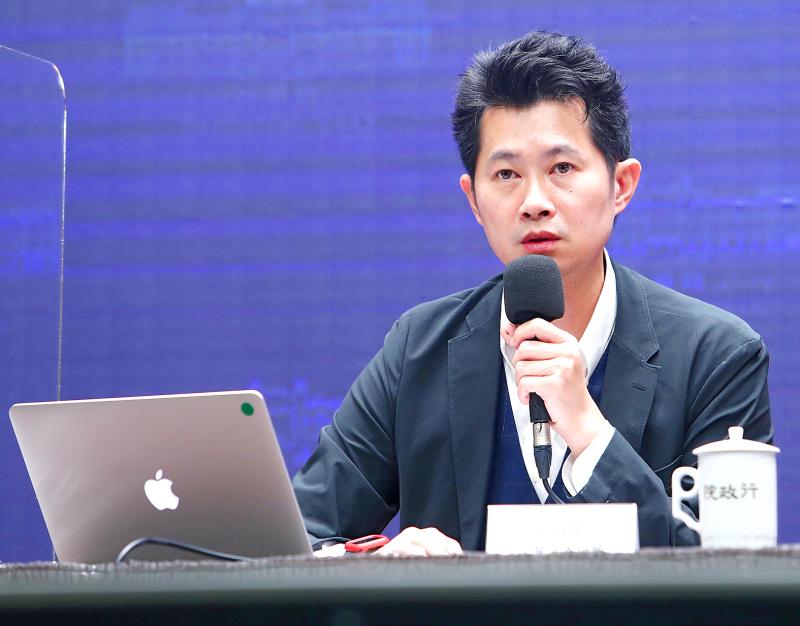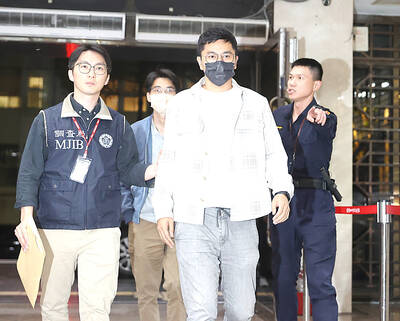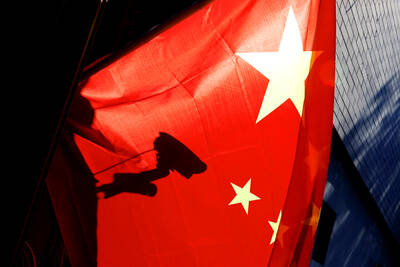Taiwanese are responsible for defending their own nation, Executive Yuan spokesman Ting Yi-ming (丁怡銘) said yesterday, after a US-based think tank published a survey that showed most Americans would be “prepared to take considerable risk” to defend US allies, including Taiwan, against military threats from China.
The Center for Strategic and International Studies survey asked members of the US public — as well as experts in national security, business, academia and human rights — about China-related issues.
Respondents were asked to rank how important it was to defend US allies in the Asia-Pacific region if they came under threat from China, on a scale from 1 to 10, with 1 representing “not worth taking any risk to protect them” and 10 “worth taking significant risk.”

Photo: CNA
The average score among the US public on the importance of defending Taiwan was 6.69, slightly lower than that for South Korea (6.92) and Japan (6.88), but higher than that for Australia (6.38).
The experts ranked the importance of defending Japan at 8.86, followed by Australia (8.71), South Korea (8.60) and Taiwan (7.93).
Taiwan would continue working to strive for international support, Ting said, adding that since President Tsai Ing-wen (蔡英文) took office in 2016, the government has been expressing its goodwill to China, while maintaining a rapport with other nations to safeguard regional peace and stability.
Taiwan’s global presence has greatly improved, as the world has seen the nation’s achievements in promoting democracy and gender equality, as well as containing COVID-19, he said.
Asked about the survey, the Ministry of Foreign Affairs yesterday reiterated the nation’s determination to boost its self-defense.
The government’s priority is to boost its self-defense capability, and that does not change based on surveys or public opinion in other countries, Department of North American Affairs Director-General Hsu You-tien (徐佑典) said.
During a videoconference on Wednesday to review the results of the survey, Bonnie Glaser, director of the center’s China Power Project, said that “support for Taiwan [in the US] is much more substantial than it was even one year ago.”
A survey last year by a Chicago think tank found that only 35 percent of Americans were in favor of US military action in support of Taiwan, Glaser said.
She attributed the change partly to growing concern in the US about China, as well as growing awareness of Taiwan, which had been prompted in part by Taiwan’s “exemplary performance in fighting the spread of COVID-19.”
The survey was conducted from July to August and received responses from 1,000 members of the public and 440 experts.
In related news, guided-missile destroyer the USS Barry sailed through the Taiwan Strait on Wednesday in what the US military described as a “routine” passage.
“The ship’s transit through the Taiwan Strait demonstrates the US commitment to a free and open Indo-Pacific [region],” a statement said. “The US Navy will continue to fly, sail and operate anywhere international law allows.”
China said that it had tracked the ship by sea and air.
“We warn the US to stop its words and deeds that provoke trouble and disturb the situation in the Taiwan Strait,” People’s Liberation Army Eastern Theater Command spokesman Colonel Zhang Chunhui (張春暉) said.
Additional reporting by AFP

‘FORM OF PROTEST’: The German Institute Taipei said it was ‘shocked’ to see Nazi symbolism used in connection with political aims as it condemned the incident Sung Chien-liang (宋建樑), who led efforts to recall Democratic Progressive Party (DPP) Legislator Lee Kun-cheng (李坤城), was released on bail of NT$80,000 yesterday amid an outcry over a Nazi armband he wore to questioning the night before. Sung arrived at the New Taipei City District Prosecutors’ Office for questioning in a recall petition forgery case on Tuesday night wearing a red armband bearing a swastika, carrying a copy of Adolf Hitler’s Mein Kampf and giving a Nazi salute. Sung left the building at 1:15am without the armband and apparently covering the book with a coat. This is a serious international scandal and Chinese

PERSONAL DATA: The implicated KMT members allegedly compiled their petitions by copying names from party lists without the consent of the people concerned Judicial authorities searched six locations yesterday and questioned six people, including one elderly Chinese Nationalist Party (KMT) member and five KMT Youth League associates, about alleged signature forgery and fraud relating to their recall efforts against two Democratic Progressive Party (DPP) legislators. After launching a probe into alleged signature forgery and related fraud in the KMT’s recall effort, prosecutors received a number of complaints, including about one petition that had 1,748 signatures of voters whose family members said they had already passed away, and also voters who said they did not approve the use of their name, Taipei Deputy Chief Prosecutor

UNDER ATTACK: Raymond Greene said there were 412 billion malicious threats in the Asia-Pacific region in the first half of 2023, with 55 percent targeting Taiwan Taiwan not only faces military intimidation from China, but is also on the front line of global cybersecurity threats, and it is taking action to counter those attacks, President William Lai (賴清德) said yesterday. Speaking at the opening of this year’s Cybersec Expo in Taipei, the president assured foreign diplomats and exhibitors that Taiwan remained committed to strengthening its defense against cyberattacks and enhancing the resilience of its digital infrastructure. Lai referenced a report from the National Security Bureau (NSB) indicating that the Government Service Network faced an average of 2.4 million intrusion attempts daily last year, more than double the figure

COUNTERINTELLIGENCE TRAINING: The ministry said 87.5 percent of the apprehended Chinese agents were reported by service members they tried to lure into becoming spies Taiwanese organized crime, illegal money lenders, temples and civic groups are complicit in Beijing’s infiltration of the armed forces, the Ministry of National Defense (MND) said in a report yesterday. Retired service members who had been turned to Beijing’s cause mainly relied on those channels to infiltrate the Taiwanese military, according to the report to be submitted to lawmakers ahead of tomorrow’s hearing on Chinese espionage in the military. Chinese intelligence typically used blackmail, Internet-based communications, bribery or debts to loan sharks to leverage active service personnel to do its bidding, it said. China’s main goals are to collect intelligence, and develop a